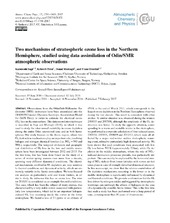| dc.description.abstract | Observations from the Odin/Sub-Millimetre Radiometer (SMR) instrument have been assimilated into the DIAMOND model (Dynamic Isentropic Assimilation Model for OdiN Data), in order to estimate the chemical ozone (O3) loss in the stratosphere. This data assimilation technique is described in Sagi and Murtagh (2016), in which it was used to study the inter-annual variability in ozone depletion during the entire Odin operational time and in both hemispheres. Our study focuses on the Arctic region, where two O3 destruction mechanisms play an important role, involving halogen and nitrogen chemical families (i.e. NOx = NO and NO2), respectively. The temporal evolution and geographical distribution of O3 loss in the low and middle stratosphere have been investigated between 2002 and 2013. For the first time, this has been done based on the study of a series of winter–spring seasons over more than a decade, spanning very different dynamical conditions. The chemical mechanisms involved in O3 depletion are very sensitive to thermal conditions and dynamical activity, which are extremely variable in the Arctic stratosphere. We have focused our analysis on particularly cold and warm winters, in order to study the influence this has on ozone loss. The winter 2010/11 is considered as an example for cold conditions. This case, which has been the subject of many studies, was characterised by a very stable vortex associated with particularly low temperatures, which led to an important halogen-induced O3 loss occurring inside the vortex in the lower stratosphere. We found a loss of 2.1 ppmv at an altitude of 450 K in the end of March 2011, which corresponds to the largest ozone depletion in the Northern Hemisphere observed during the last decade. This result is consistent with other studies. A similar situation was observed during the winters 2004/05 and 2007/08, although the amplitude of the O3 destruction was lower. To study the opposite situation, corresponding to a warm and unstable winter in the stratosphere, we performed a composite calculation of four selected cases, 2003/04, 2005/06, 2008/09 and 2012/13, which were all affected by a major mid-winter sudden stratospheric warming event, related to particularly high dynamical activity. We have shown that such conditions were associated with low O3 loss below 500 K (approximately 20 km), while O3 depletion in the middle stratosphere, where the role of NOx-induced destruction processes prevails, was particularly important. This can mainly be explained by the horizontal mixing of NOx-rich air from lower latitudes with vortex air that takes place in case of strongly disturbed dynamical situation. In this manuscript, we show that the relative contribution of O3 depletion mechanisms occurring in the lower or in the middle stratosphere is significantly influenced by dynamical and thermal conditions. We provide confirmation that the O3 loss driven by nitrogen oxides and triggered by stratospheric warmings can outweigh the effects of halogens in the case of a dynamically unstable Arctic winter. This is the first time that such a study has been performed over a long period of time, covering more than 10 years of observations. | en_US |

